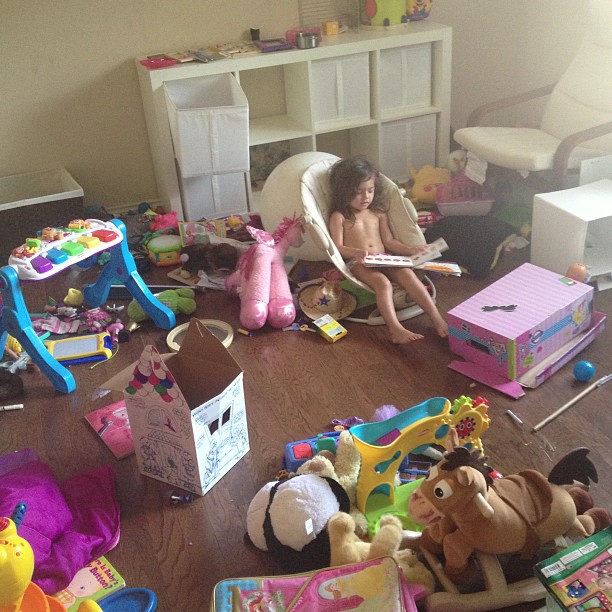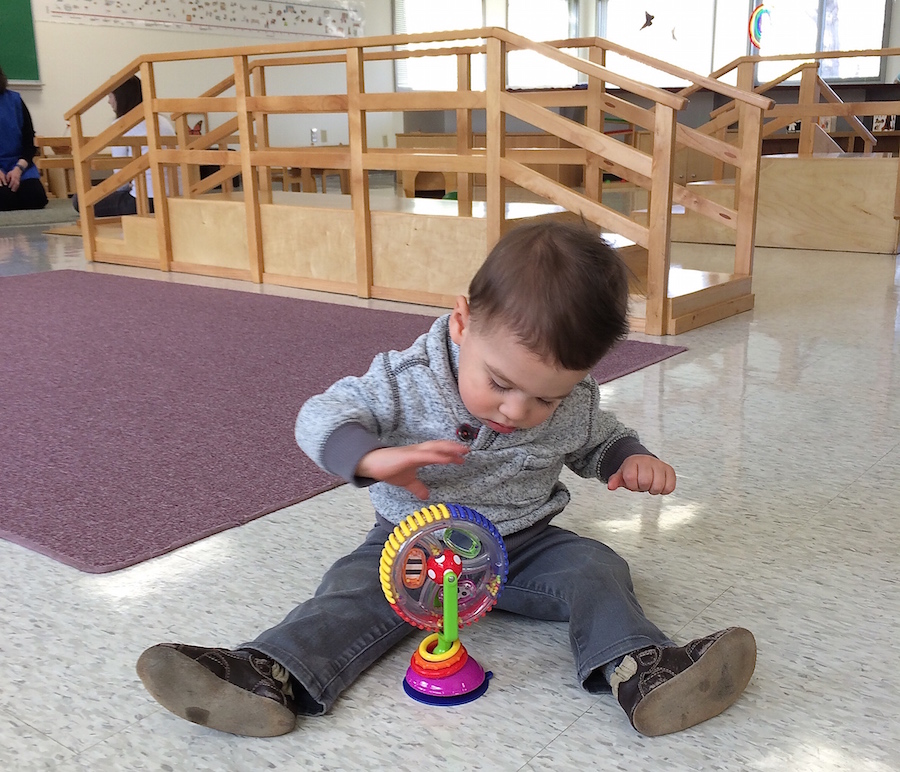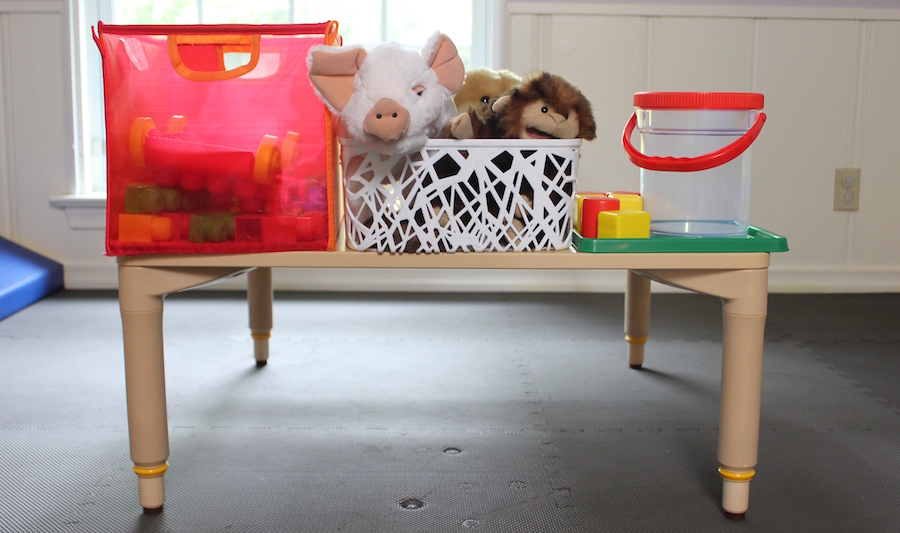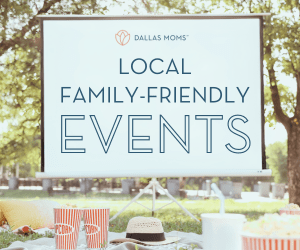Recently I shared why I got rid of my wardrobe. But long before I tackled my closet, I took on the toys. I vowed there would be no more stepping on Legos in the middle of the night and tripping over blocks. Too many toys are a safety hazard and a sanity hazard.
I have to argue that any child would be completely overwhelmed with a selection of toys as lengthy as the Cheesecake Factory Menu. Just like I felt about my wardrobe, I believe maintaining a short “fine-dining” menu of higher quality, carefully chosen toys is a better fit for children.

So I knew what I didn’t want: toy chaos. What I did want was a tranquil space for my son to play independently. After all, we know kids learn through play. So I pictured his playroom to be like his office. The place were the real work (a.k.a playing) gets done.
We started to learn about a child’s “work” when we enrolled Nicolas in a playgroup in our neighborhood. It was at a Montessori school–which we didn’t know a thing about. The first week, my husband David took him to the group. David came back from the group with an excited but confused mix of feelings. He explained to me that the classroom felt empty–maybe even a little boring.
David told me everything in the classroom had its place. Each toy in the classroom had its own little basket and a special spot on the shelf. And the rule was that each child should only play with one toy at a time, and put it away when they are done. Groundbreaking, right? What’s more, he said that all of the kids were completely engaged in the few toys the room had to offer. There was no mischief-making…no one trying to unload the teacher’s cupboards, bite their friends, or run out of the room. I was intrigued.

The following week I observed it myself for the first time. After my first observation, I was sure that the school was lacing the Kool-Aid with a special rule-following medication. Either that or it was a cult. I couldn’t get over how well the children played independently. They were completely absorbed and occupied in their tasks at hand. I was determined to figure out what the secret was so I could jump on the bandwagon and bring it home.
I started to read a little more on the school’s philosophy behind their seemingly minimalist classrooms. I quickly came across a blog post entitled “There’s just too much stuff.” It resonated with me because, like most of America, we.just.have.too.much.stuff. I found out the answer to my problem was having fewer toys, and picking the right toys. To quote the author:
The things we surround ourselves with are not always lovely, not always useful or meaningful. In our house, we have closets and a garage full of things we don’t really need or use. We have living spaces that are cluttered with toys, books, games, art projects and the like. Often these things have missing or broken pieces…What I will do is be more deliberate about what we really need, what is truly engaging, and what is lovely and pleasing to us. I intend to be more thoughtful in how these things are arranged, displayed and organized. Nothing is stacked or hidden, nothing is in a toy box or in cluttered bins. The children can see the materials, can access them easily, and can put them away with ease.
And with that quote, I was sold. Hook, line, and sinker.

We created our son’s office playroom in a way that we hope he will be learning and playing in for years to come. Is it extreme? Yes, absolutely. But we have already seen how wonderful it has been for his play, development, and sanity (heck, mostly our sanity). Here’s how we did it.
1. We started with a completely bare space. Starting with an empty play room allowed us to add each item in one-by-one with careful consideration.
2. We got the right organizers. Toy boxes and large bins are a bottomless pit that invite dumping. Instead, we have trays and short (6 inches) containers that can easily be accessed without mess making. These types of storage containers ensure that the items are easy to see, easy to access, and contained.


3. We found a toy-style. Just like people have different clothing styles, there are also different toy styles. This grandma’s toy-style really stuck with me.
Several years ago, I was trying to find a hobbyhorse, the kind that has a horse’s head on a stick, for my youngest granddaughter who had fallen in love with all things horsey. Much to my surprise, I could never find one that didn’t make all sorts of horse sounds and play cowboy songs — we quickly removed the batteries. A silent horse allowed her to create her own sounds and stories.
Our toy-style includes mostly toys that are task-based (a shape sorter, a puzzle—generally toys that you can “complete” or master). We also try to incorporate many open-ended toys, much like the silent horse.

Although it may be controversial, we request “no gifts” at birthday parties. Our close family and friends spend time with him and are familiar with our toy-style. They tend to purchase great additions to his space. If we do receive a gift thats not “our style”, we try to repurpose it or donate it to a good cause. If someone gifted me some jeans that were clearly too small or weren’t my style, it is unlikely to would wear them. I don’t think the use of toys should be much different.
4. We changed how we buy toys. Rather than sticking to the birthdays and holidays to buy toys, I buy them year around. We have a “one-in-one out” policy, with 15 toys and 8 books in the playroom at any given time. I buy toys used as much as possible. And when he outgrows them, I put them into storage for our future children.
I don’t get sucked in to things that “look super fun”. I buy toys all year to meet his developmental needs and interests-which are always changing. Once he masters the chunky shape puzzles, it’s time to move onto the jigsaw. Keeping the toys appropriate for his current age keeps him engaged. If the room was filled with toys that were too baby-ish or too mature, he would either ignore them or play with them inappropriately.
5. We keep variety. I always make sure to keep at least one of each of following types of toys: Gross motor, fine motor, plush, stacking, building, connecting, puzzles, pretend play, musical play, art play, and of course books–the books are rotated regularly.
6. We keep it minimal. I rarely put out an entire set of anything. Does he really need access to all 300 Mega Blocks that came in the set? No. Usually 50 will do the job. And he only needs one Thomas the Tank Engine. He does not need Birthday Thomas, Musical Thomas, Light-up Thomas, AND Halloween Thomas. Setting boundaries helps to free up space in the room and makes for easy clean up.
Speaking of clean up…it’s so easy. If I do it myself after bedtime it takes me 1 minute and 20 seconds (yes, I timed it) to put everything back in perfect working order. If Nicolas helps, it obviously takes a bit longer. It’s not always clean. And he doesn’t always (or even usually) put away the toys as he plays. But I feel good about where we are at right now.

I don’t want to spend the next decade yelling at my kids to clean up their toys. If the toys are manageable they will not only be easier to clean up, but easier to get out and enjoy.
And he does enjoy them. Nicolas is an incredibly happy, busy little man. I feel confident that these toys provide him with a lot of fun and numerous opportunities of exploration and creativity.
What do you think of our toy philosophy? I know it will get challenging as he gets older. And even more challenging as we think about adding more children to our family.
Do you think you could make something similar work in your house?
This Dallas Moms Blog original post was featured on August 13, 2015 by The Today Show. We’re proud of our website and the amazing expertise all of our contributors bring to this collaborative website! You can see the video here:
[xyz-ihs snippet=”Today-Show–Rid-of-Toys”]














I’m really interested in this model. How did you deal with your child asking for toys that you got rid of? Or did you just rotate them out and bring them back in? What do you do if your child asks for a toy that is not currently in rotation? My daughter, at two, is very verbal about what she wants to play with if she cannot find it.
Also, did you make this change overnight or gradually?
And how did you decide on 15 toys and 8 books? Would it be inappropriate to have more books, especially if on any given day, my daughter and I will sit through reading/listening to 6-8 books?
Thanks.
I love this philosophy and have kind of employed it. We repurposed our front room into a playroom, and we sold or donated many boxes of toys after we moved last summer. The problem I have is that it is much harder to keep minimal with 3 kids. They are all at different stages and have different learning and play needs. And of course the 2yo wants everything the older kids play with so separation and organization are not ideal, if not impossible. We invested in large, non electric toys to enhance imagination and gross motor skills (play kitchen, climber with slide, tent) and keep things like blocks, books, doctor kit and cars in the toy shelf. The older kids keep legos and barbies in their respective rooms, and have to ask for them to be brought out of the closet.
As for birthdays, we try to swap new toys for old toys. For my older son’s birthday, we talked about toy excess and decided to collect donations for the Zoo instead. He loved that and we made a special day of delivering the donations in person.
I just had my first child and he’s 3 months old. I like your philosophy on toys. Can you recommend specific toys that will help him his skills for the first year of his life? Any brands that are good? Thanks
Also what’s a good mobile?
Jasleen, Thanks for reading!
I wrote this post for my former blog last year–all about activities for the first year:
http://www.bumbleandbliss.com/2014/12/survival-guide-activities-for-babies-in.html
And this is my favorite mobile for the 0-5 month crowd–it is a great developmental tool for developing vision:
http://www.amazon.com/Manhattan-Toy-Wimmer-Ferguson-Infant-Stim-Mobile/dp/B00009ZIKH
I love this post! This is the outcome that I am aiming for, for my two boys. Unfortunately I haven’t got it figured out yet. Thanks for the inspiration!
I applaud you for doing something so drastic and different from what our culture sells! I believe that despite challenges you will be able to maintain most of this toy philosophy through out your family changes. I have three boys (5,3,18month) and we absolutely try to minimalize, be intentional with what toys we buy and keep it organized! Our style with young boys is big on super heroes, Legos, and cars. The biggest challenge is dealing with the “junk” toys that family often buy. Which we try to divert them from by asking for swim lessons, a soccer season, zoo pass, museum pass and the like.
I love your idea of asking for lessons or passes to child friendly places that they can learn as well. Thank you for that.
I wish you could come help me build and create my son’s space. Sigh. I figure by the time I get a handle on one developmental stage he’ll have out grow. It. 🙁
And where do I get the good toys? Mostly my son plays with kitchen stuff but I wonder if that’s because I don’t have his toys set up well. They are in big clear plastic bins on the floor. We keep it minimal but he doesn’t play with any of it very much.
Kitchen stuff is wonderful! We keep all our toys on bookshelves – either right on the shelves or in clear shoebox sized Sterilite bins. It is very organized and also inviting this way; they can see everything. I have all boys from toddler to tweens, and these are the enduring toys that even the older ones still enjoy with the littlest one: Wooden blocks, Playmobil anything!, Duplo & Lego, play food, art supplies (paint, crayons, markers, scissors, paper, dough, rubber stamps), music, books, balls, bikes, whiffle ball, swing, slide, trampoline, sand…That’s a lot, but basically open-ended creative toys and plenty of fresh air are all you need!
Great post , it is encouraging me to get back to the similar model we imemented about two years ago. Unfortunately we got away from it but I am definitely going back to it. I have 6 children and expecting #7 in December! We definitely need to get the chaos under control again.
What we did was allow the older children to pick 10 toys that they really wanted to keep. We allowed them to keep certain “sets” and count it as one item (my younger son has a small “car town” as he calls it and 3 cars, we counted that as one). We also implemented the one-in-one-out rule. If a new toy came in, one had to be chosen to give away. When allowing the older ones to choose, we a time frame by which they had to come to a decision or we told them we would decide for them (one week). We ultimately helped choose anyway as they would ask for help. They quickly realized they had way too much and it was hard to choose. We had a large toy bin that they would just dump out to find the one small you they were looking for and then leave the mess.
Anyway, thanks for the reminder and I am encouraged to get back to sanity.
I don’t agree with everything in this post. I feel limitations in certain aspects of play stifle the ability to be creative and play/learn in a manner outside of what would be considered acceptable. It is the same argument with any formal education. Formal educations is designed to make us think, act, behave, a certain way that is all proper. Kids, especially young kids shouldn’t be pigeon holed into “proper” let the kids be kids and get them out of the things have to be this way or that. I am not knocking your method as I never would, what simply works for some will not work for all. If it works for you and your child that is wonderful.
Yeah, while much of it seems like a good idea, I was wondering about “If the room was filled with toys that were too baby-ish or too mature, he would either ignore them or play with them inappropriately.” What is inappropriate play? If you’re talking about violence or destruction, fair enough (although I think it can be helpful to learn that if you break something, it’s broken), but other than that, all play is appropriate play. Children learn through play; they don’t need all toys to be specifically designed as a learning experience. Imagination and creativity are important and deciding what a child is doing with a toy is inappropriate seems harsh to me.
I figured out that giving my kids the right toys for their ages helped because if they were too old or young for a certain toy, they would just lose interest in it pretty quickly – that’s why, I guess, toys are designated for certain ages, they meet the current demand of each age. Kids will play basically with anything, but I guess it works better with very basic things like blocks or rocks or sand, and that’s what I experienced – if the toy didn’t meet the age of my kids, it very quickly became just clutter.
I assume she means in a way that’s destructive or just making a mess with it without playing with it. In that case, it becomes a burden of toys that they wade though to find the ones they’re interested in.
But I doubt I will ever see much in common with someone who spurns “formal” education on such grounds. (Yikes!)
I love this idea thank you for sharing! My LO just turned 1 and I’m a little overwhelmed on how to get this started..where do you purchase your toys? Thank you in advance and look forward to hearing from you!
You can find these basic and lasting toys in toy stores, amazon.com, and many regular big box stores (all mine from toddler to tween love these): wooden blocks, Duplo (for toddlers) and then Lego, puzzles labeled as safe for toddlers, Playmobil (123 for toddlers and regular for ages 3+), make or buy dough, play with sand in a flat container or pan or outside.
Love this. We are in the process of moving and packed up all the kids toys. They have not had a problem at all. They find plenty of things to do and we do a lot more together, like cooking and cleaning. I love it. When we move I want to be really thoughtful of how I put together their playroom. A couple of things I do with multiple children is each child has a bed basket. We use it to put stuff in they want to look through at bed time but they also put their toys in it they don’t want to share. These are sometimes special things they got for birthdays and such. Also with birthday gifts, when someone asks us what kind of present they want, we always say books, craft kits or games. That is also what we buy for our friends for gifts. I think gift giving is fun and so that is something we continue to participate in. I have found that gifts that fit into these categories also fit into our lifestyle. Thanks for sharing your playroom!